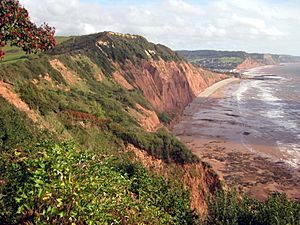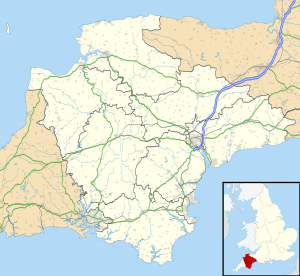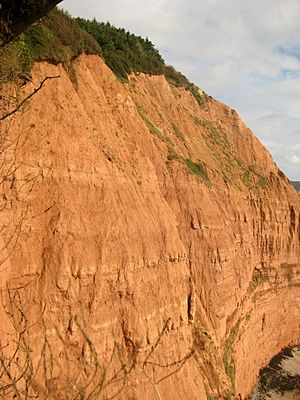High Peak, Devon facts for kids
Quick facts for kids High Peak, Devon |
|
|---|---|

Peak Hill cliff face with view to Sidmouth Beach
|
|
| Location | Devon, England |
| Coordinates | 50°39′50″N 3°16′39″W / 50.6640°N 3.2774°W |
High Peak, also called Peak Hill, is a cool hill in Devon, England. It sits right on the English Channel coast, near Sidmouth. Part of the hill has worn away, forming a tall cliff. Its highest point is about 157 meters (515 feet) above the sea. Long ago, it was an Iron Age hill fort, a type of ancient fort. People have found old pottery there from before and after Roman times.
A Look Back in Time: High Peak's History
High Peak has a long and interesting history! On the cliff edge, you can still see parts of old earthworks. These are like big ditches and banks made by people. Experts think these earthworks show that people lived here during the Iron Age, Roman times, and the Dark Age.
Scientists have studied the rocks and the shape of the earthworks. They believe that this site used to be much bigger. It probably stretched many meters further out into what is now the sea.
Most people think High Peak was first used as a defensive site during the Iron Age. This means it was a place to protect people from enemies. Later, in the Dark Age, it might have been used again. Perhaps it became a busy trading station along the coast.
Uncovering High Peak's Geology
The cliffs below High Peak and Chit Rocks are very special. Scientists have found some super rare fossils here. These fossils include ancient fish, reptiles, and amphibians. They lived during the Triassic Period, millions of years ago!
Layers of Rock
The cliff face at High Peak shows four main layers of rock. These layers are called strata. Each layer tells a story about Earth's past.
The bottom layer is called the "Otter Sandstone Formation". These rocks were formed about 220 million years ago. Back then, the climate was very hot and dry.
Above the sandstone, you'll find rocks from the Mercia Mudstone Group. These layers formed around 200 million years ago.
On top of these older layers, there are rocks called Upper Greensand. This rock formation is from the Cretaceous Period, about 80 million years ago.
The very top of High Peak is covered in flint gravel. This gravel was likely left behind after a layer of chalk wore away. This happened during the early Palaeogene period, about 60 to 66 million years ago.



